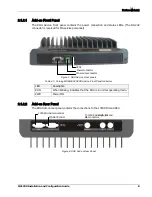
Preface Material
MA1000 Installation and Configuration Guide
15
3.4.2
Power Consumption of Units
Table
3-1. Corning MOBILEACCESS™ Power Requirements
Unit Type
Voltage Input Typical Power
Consumption
Maximum Current
Consumption
Remote Unit 1000
20 to 48VDC
25W
1.25A
Remote Unit 1000E 20 to 48 VDC
29W
1.45A
Add-on
25 to 48VDC
50W
2.0A
RIU – 3 BTSCs
20 to 48VDC
12W
0.6A
Base Unit
20 to 48VDC
14W
0.7A
410/430 Controller 20 to 48VDC
10W
0.5A
860
20 to 48VDC
20W
1.0A
3.4.3
Circuit Breakers
Install fuse protections for the system according to the following criteria:
•
The following system elements require external fuse protection: RIUs, BUs, 410, 430
and SC-450 Controllers.
•
Referring to Table
3-1, calculate the required fuse protection.
•
Example: a set of three elements consisting of a BU, RIU and 410, 430 or SC-450
controller requires a 2A circuit breaker.
3.4.4
Types of Power Supplies
Corning MobileAccess supplies various power supplies that can be installed in a rack or mounted
on a wall, depending on your configuration.
3.5
Installation Conventions
Some of the basic installation conventions are listed below for the 1000 system:
•
Base Units – are usually concentrated in the same location, most often in the main
communication room.
•
Remote Hub Units usually placed in the communication shaft or closet of a
corresponding floor so they can be easily located. Each RHU can typically cover a floor of
up to 30,000 sq ft.
•
Fiber optic cable - bundled fibers are terminated into the Base Units in the main
communication room. The fibers are then routed to each coverage location where
individual fibers terminate into splice boxes. The splice box couples the installed fiber
into the remote units. Enough spare fibers should be installed to take into account future
expansion of the system.
For example, for three remote units, six fibers are required. However, to allow for future
upgrades, it is recommended to install additional optic fibers to be connected to additional
RHUs.
The following figure illustrates fiber optic routing sufficient to cover 21 floors: each group of
strands can cover three floors as illustrated below, with two strands to spare. The first group
















































